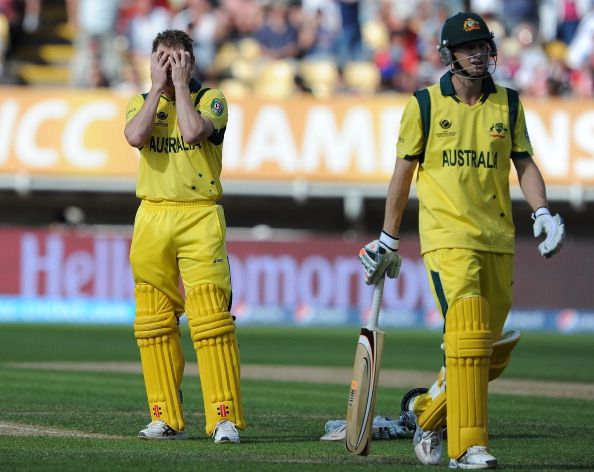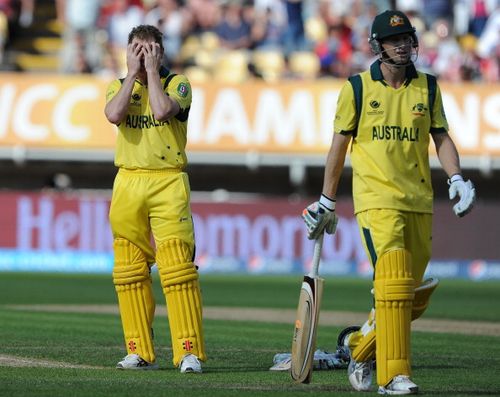
ICC Champions Trophy 2013: It's now or never for Australia
The signs were there in Cardiff, they just got confirmed at Edgbaston.

Australia’s Adam Voges leaves the field (R) as Australia’s George Bailey (L) reacts after Voges was bowled out by England’s Tim Bresnan during the 2013 ICC Champions Trophy cricket match between England and Australia at Edgbaston in Birmingham, central England on June 8, 2013.
For a while now, the Australian domestic structure hasn’t been churning out world-class batsman as regularly as it used to, and the repercussions are felt at the international stage. After falling over for a paltry 65 against India, albeit in a warm-up tie, the Aussie lineup came up with another timid show against England.
Its not that there is a dearth of talent. Certainly the Ponting and the Hussey-sized holes are difficult to fill, but if points are awarded for potential, this team will still get a high score. It’s the way they went about their innings that left a lot to be desired.
Chasing 270, which at the innings break was considered a par score on a placid track, there seemed no urgency as the innings huffed and puffed all along and at no point threatened to get anywhere near the target. Apart from the stand-in skipper George Bailey, who waged a lone war with a fighting 55, the plan, if there was one, for the rest of the lineup went haywire against a disciplined attack.
The openers, Shane Watson and David Warner, known for their slam-bang methods, were tied in knots and never allowed to break free before succumbing to the pressure. With two new balls and quality opening bowlers in operation, the idea probably was to see off the early period. Fair enough. But trouble starts the moment one deviates from his natural game. It’s the aggressive route that makes the duo the potent pair they are, and being overly cautious and allowing the bowlers to dictate terms only made the target look bigger than it actually was.
Being able to take the ones and twos in the middle overs is one of the most important aspect in the 50-over version, and Phillip Hughes learned it the hard way. His problems against spinners in India are well-documented and England surely had done their research on him.
Hughes started well, scoring 10 off the first 15 deliveries he faced from the seamers, but got stuck once James Tredwell got into the attack. Even against the part-time effort from Joe Root, he failed to rotate the strike and got bogged down before an ugly slog to break the shackles got him trapped in front of the stumps. Now it will be too much to suddenly expect him to use his feet and hit the spinners out of the park; but as a top-order batsman, he should be capable enough to milk them around and keep the scoreboard ticking.
Even as the required rate moved upwards of 8 an over, the need of the hour for the lower middle-order was to stay with Bailey and get a partnership going. But the likes of Adam Voges, Mitchell Marsh and Mathew Wade showed their inexperience in international cricket by playing outrageous shots in pursuit of quick runs. Scoring in the batting power-play is still a puzzle for other teams as well; but instead of across the line hoicks, there should be more emphasis on the percentage shots.
Though Mitchell Starc got a bit of stick, there isn’t much to fault about in the bowling department. Given the kind of platform that had been set by the English top order, they actually did well to restrict the English batsman to 269. More than the bowlers though, the decision-making of the team management must improve. Despite playing on dry wickets, their reluctance to include Xavier Doherty has been baffling. Not that Doherty would run through batting lineups, but his inclusion at least wont be defying logic.
As Bailey and Co step out on the field today to face New Zealand, their rivals from across The Ditch, to stay alive in the tournament, they will be up against one of their biggest challenges in one-day cricket in recent times. The Australians are no strangers to drama at Edgbaston – the tied 1999 World Cup semi final and the second Ashes test in 2005 come to mind- and they would be keen to conjure up some magic at this historic ground one more time to mark the beginning of another renaissance.
But for that to happen, all eleven players will have to be at their very best; otherwise, the last piece of silverware in their trophy cabinet too will make its way out.